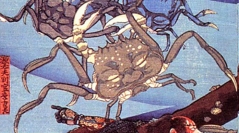

 Zoosystema
45 (9) - Pages 225-372
Zoosystema
45 (9) - Pages 225-372A new and revised classification of the small family Dorippidae H. Milne Edwards, 1837, which previously comprised two distinct subfamilies (Dorippinae H. Milne Edwards, 1837 and Ethusinae Guinot, 1977), each of which was subsequently elevated to a familial rank supported by traditional data and genetic phylogenies, is presented on the basis of a morphological analysis involving a large number of characters. The family is in fact highly diverse, at all levels. Several features are described and depicted in detail here for the first time, e.g. the presence of a diversely developed strip along the protrudingly rimmed posterior margin of the carapace; on the dorsally exposed thoracic sternite 8, a process acting as an additional pleonal-retention mechanism in the females of three genera (Dorippe Weber, 1795; Philippidorippe Chen, 1986; Phyllodorippe Manning & Holthuis, 1981); a callosity at the base of the coxa of the third pereiopod, variously shaped, in two genera (Dorippe and Dorippoides Serène & Romimohtarto, 1969). The generic and specific taxonomy masterfully stabilised by Holthuis & Manning (1991) is undisputed and still valid, except for the composition of the genus Heikeopsis Ng, Guinot & Davie, 2008 that may well contain in northern China a form not entirely consistent with the typical Heikeopsis japonica (von Siebold, 1824) of Japan. A second exception concerns the genus Paradorippe Serène & Romimohtarto, 1969 sensu Holthuis & Manning (1991) that may not be monophyletic. The validity of Medorippe crosnieri Chen, 1988, questioned by Holthuis & Manning (1990), could not be confirmed here: its distinctive morphological characters from M. lanata (Linnaeus, 1767) suggest that it could be recognised one day. The synthesis of conventional and new characters allows the traditional taxonomic approach to be updated and modernised, more complete and robust diagnoses to be constructed, and groups of genera to be circumscribed. We propose a new subfamily classification whereby the family Dorippidae is recognised as monophyletic but with seven genera assigned to subfamily-level rank, leading to the recognition of seven distinct subfamilies: the Dorippinae H. Milne Edwards, 1837 n. stat. (Dorippe), Dorippoidinae n. subfam. (Dorippoides), Medorippinae n. subfam. (Medorippe Manning & Holthuis, 1981), Heikeopsinae n. subfam. (Heikeopsis, Neodorippe Serène & Romimohtarto, 1969, Nobilum Serène & Romimohtarto, 1969), Paradorippinae n. subfam. (Paradorippe), Philippidorippinae n. subfam. (Philippidorippe) and Phyllodorippinae n. subfam. (Phyllodorippe). There is a high degree of concordance between several elements of our proposal: 1) the main morphological patterns of the male gonopods lead to the recognition of seven subfamilies; 2) the main morphological patterns of the vulvae correspond to the seven observed gonopod types and lead to the recognition of the same seven subfamilies; 3) the recognition of several subfamilies is supported by the well-defined clades obtained by the molecular analyses; and 4) the female reproductive system, recently documented by histologists in most genera of Dorippidae, which differs from that of all other eubrachyurans studied so far, with an arrangement that undoubtedly represents a new type of organisation, unparalleled in the Brachyura Brünnich, 1772: it further shows unexpected diversity, with a degree of divergence similar to that of the gonopods and vulvae, in accordance with the subfamilies here recognised. A new interpretation of the two main grooves on the dorsal surface of the carapace is widely discussed. The authorship of the family-group name Dorippidae is here ascribed to H. Milne Edwards (1837). The study of Dorippidae is a particular example of how the integration of data from various fields, such as morphological and molecular phylogenetics, larval and post-larval features, behaviour and palaeontology, offers opportunities for reciprocal illumination. The early diversification of the family and its basal position among the Eubrachyura Saint Laurent, 1980 are supported not only by morphological traits but also by other characters, such as spermatozoal ultrastructure, carrying behaviour, forward locomotion and forward burying behaviour, all of which set the family apart from all other Eubrachyura. The substantial morphological variety of female reproductive systems within the Dorippidae, with the discovery in some species of external fertilisation sites, in contrast to the internal fertilisation that is assumed to define all eubrachyurans, challenges several previous ideas on the evolution of sperm storage in Eubrachyura and raises more questions than it answers. According to histologists, the arrangement of the Dorippidae suggests that the family could be sister to a clade including the Heterotremata Guinot, 1977 and the Thoracotremata Guinot, 1977. Two keys to the subfamilies, one based on gonopods and vulvae, the second based on other morphological characters, are provided. The taxonomy, including extant and fossil forms, is accompanied by justifications for the arrangement we propose. The Dorippidae proves to be a special lineage within the Eubrachyura: its diverse and unique features are discussed. The dorippids in legend and myth are the subject of Appendix 1. Fossil Dorippidae and Ethusidae Guinot, 1977 are reviewed, as well as the two extinct dorippoid families (Telamonocarcinidae Larghi, 2004; Tepexicarcinidae Luque, 2015), and also fossil families that were at one time considered to belong to the Dorippoidea, such as Goniochelidae Schweitzer & Feldmann, 2011 (see Appendix 2).
new characters, new diagnoses, identification keys, carapace grooves, female reproductive system, molecular analysis, fossil taxa, Ethusidae, samurai crab, new status, new subfamilies